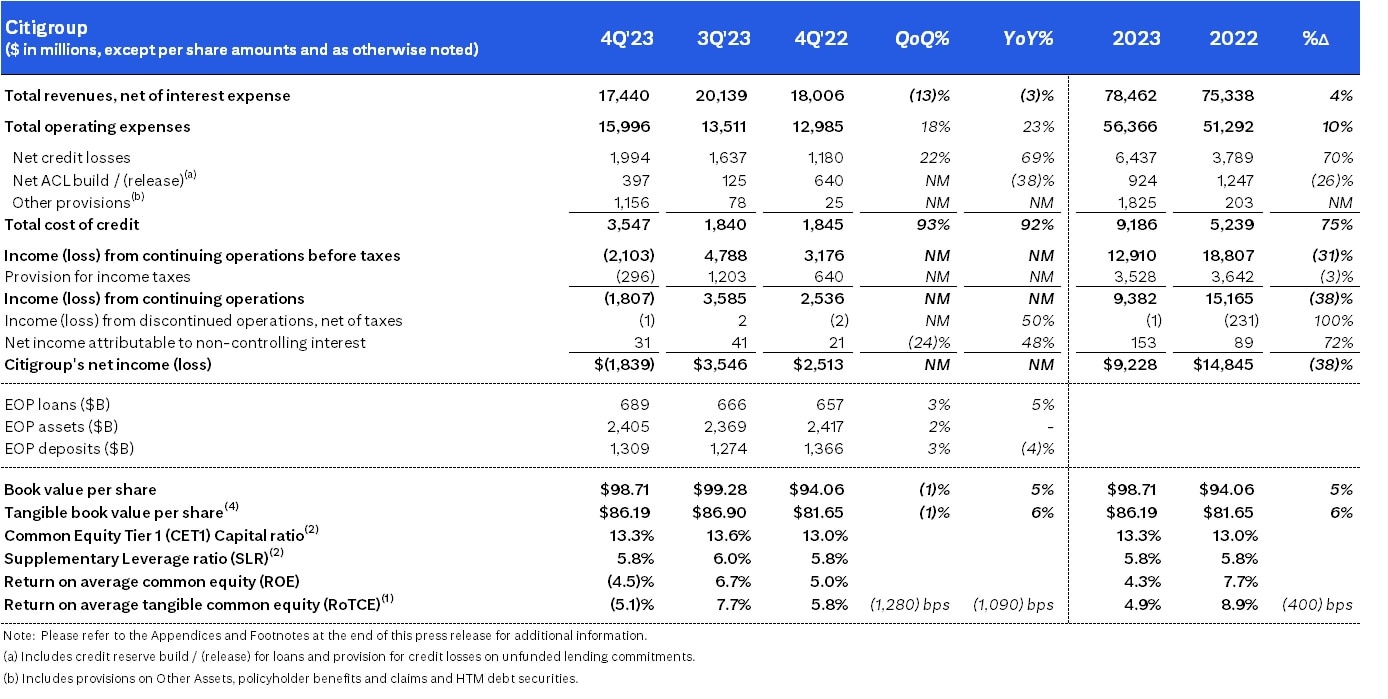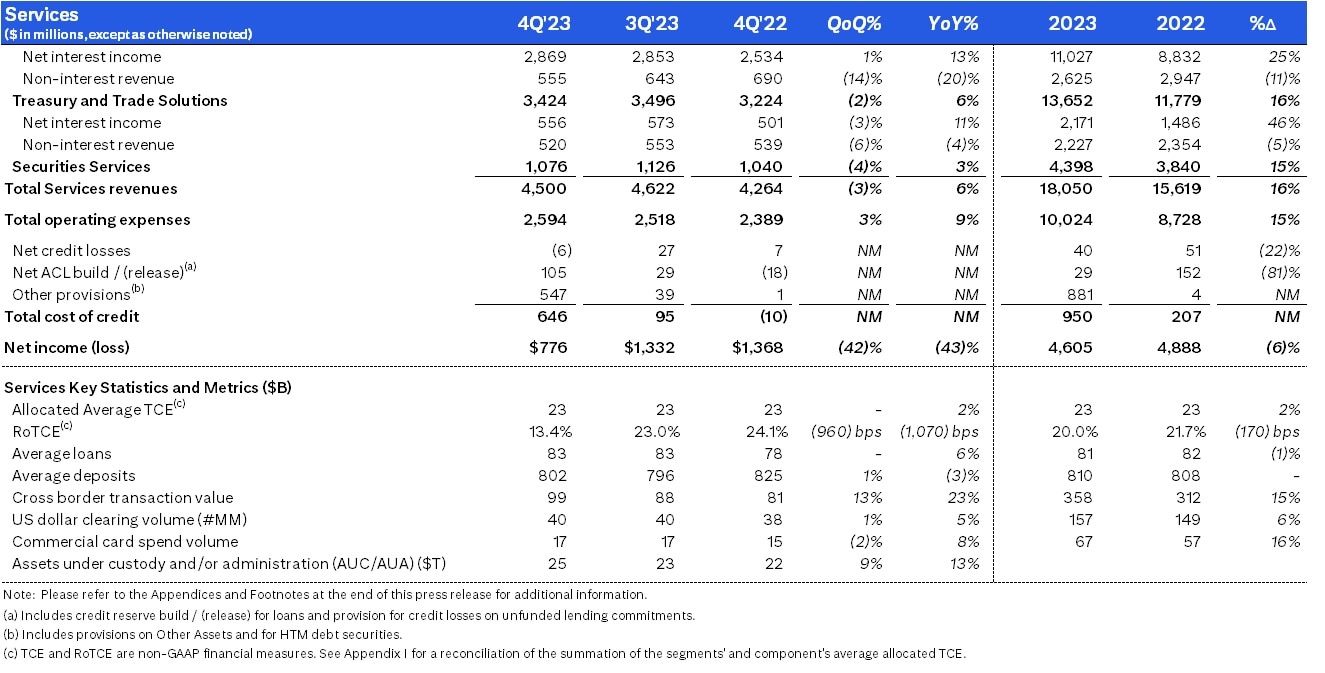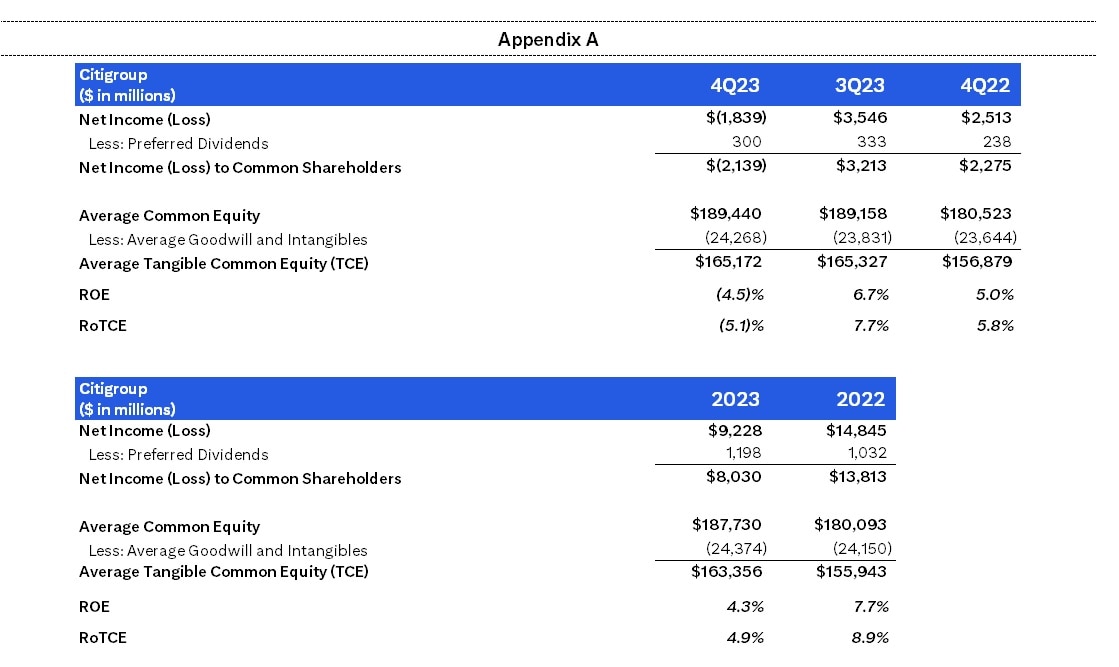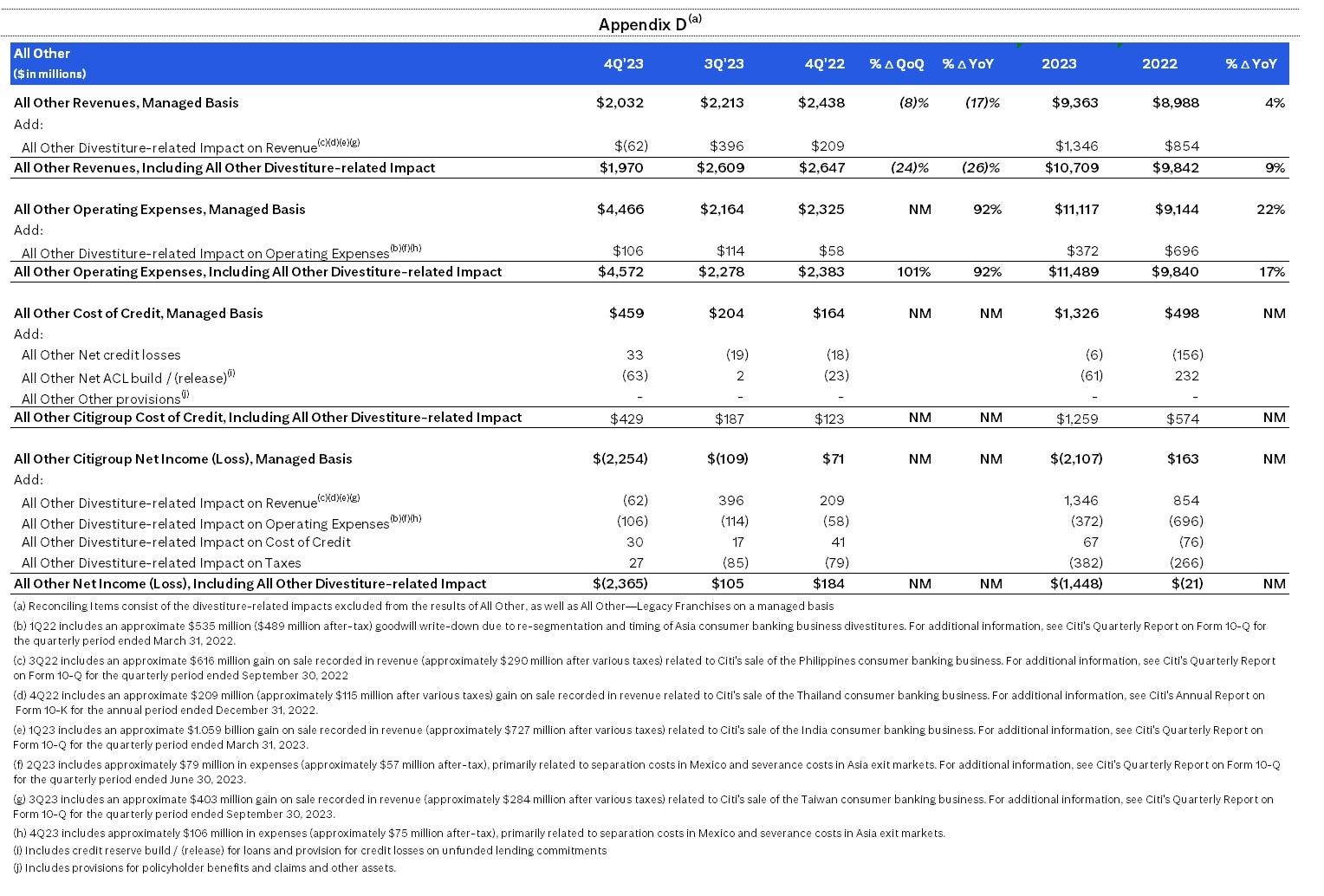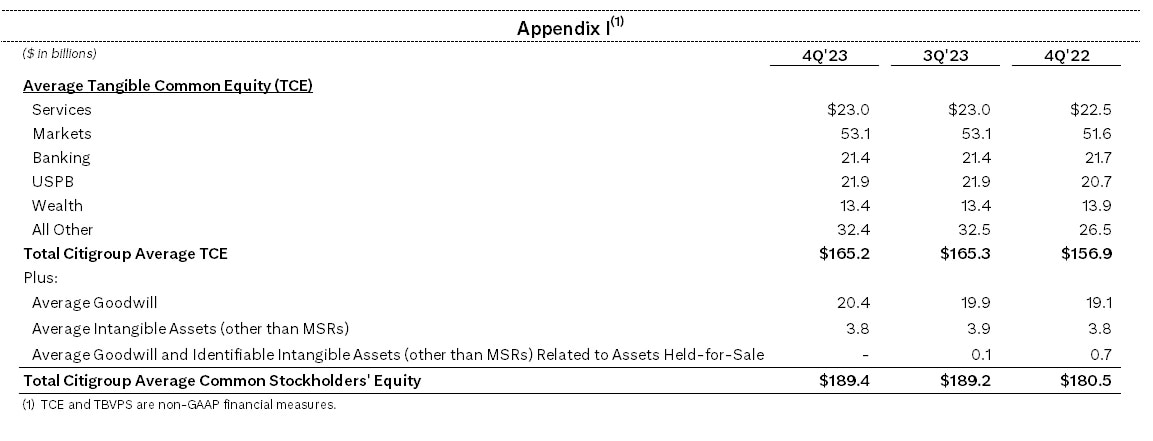Fourth Quarter and Full Year 2023 Results and Key Metrics
HIGHLIGHTS
- RETURNED ~$6 BILLION IN THE FORM OF DIVIDENDS AND REPURCHASES IN 2023 (~$1.5 BILLION IN THE QUARTER)
- 2023 PAYOUT RATIO OF 76%3
- BOOK VALUE PER SHARE OF $98.71
- TANGIBLE BOOK VALUE PER SHARE OF $86.194
Read the full press release with tables and CEO commentary
View the Financial Supplement (PDF)
View Financial Supplement (Excel)
New York, January 12, 2024 – Citigroup Inc. today reported net loss for the fourth quarter 2023 of $(1.8) billion, or $(1.16) per diluted share, on revenues of $17.4 billion. This compares to net income of $2.5 billion, or $1.16 per diluted share, on revenues of $18.0 billion for the fourth quarter 2022.
As previously disclosed5, fourth quarter results included several notable items consisting of: expenses associated with the Federal Deposit Insurance Corporation (FDIC) special assessment of approximately $1.7 billion pre-tax; a reserve build of $1.3 billion associated with transfer risk in Russia and Argentina; the pre-tax revenue impact from the fourth quarter of 2023 devaluation of the Argentine peso of approximately $880 million6; and a restructuring charge of approximately $780 million related to actions taken as part of Citi’s organizational simplification. The combination of these items negatively impacted diluted earnings per share by approximately $2.00. Excluding these items5, diluted earnings per share would have been $0.84 for the quarter.
Revenues decreased 3% from the prior-year period on a reported basis. Excluding divestiture-related impacts7 and the pre-tax impact of the Argentina devaluation, revenues increased 2%, driven by strength across Services, US Personal Banking (USPB) and Investment Banking, partially offset by lower revenues in Markets and Wealth and the revenue reduction from the closed exits and wind-downs.
Net loss of $(1.8) billion decreased from $2.5 billion of net income in the prior-year period, primarily driven by higher expenses, higher cost of credit and the lower revenues.
Earnings per share of $(1.16) decreased from $1.16 per diluted share in the prior-year period, reflecting the net loss.
For the full year 2023, Citigroup reported net income of $9.2 billion, on revenues of $78.5 billion, compared to net income of $14.8 billion on revenues of $75.3 billion for the full year 2022.
Percentage comparisons throughout this press release are calculated for the fourth quarter 2023 versus the fourth quarter 2022, unless otherwise specified.
Citi CEO Jane Fraser said, “While the fourth quarter was very disappointing due to the impact of notable items, we made substantial progress simplifying Citi and executing our strategy in 2023. We restructured around five core, interconnected businesses to align our organization with our strategy and to provide greater transparency into their performance. Revenues ex-divestitures grew by 4%7 and we met our full-year expense guidance. We increased our CET1 ratio to 13.3%, grew our Tangible Book Value per share by 6% to $86.19, and returned $6 billion in capital to our shareholders in the form of common dividends and share buybacks.
“Services revenues were up 16% for the year driven by share gains and client wins. In Markets, our fourth quarter Fixed Income results were disappointing as we saw a significant slowdown in December. We had a decent quarter in Equities, particularly in Derivatives, and saw growth in Prime balances. Investment Banking revenue continued to be impacted by a weak wallet globally while activity picked up in the fourth quarter with revenues up 27%. While investment activity in Asia rebounded during the quarter, up 21%, Wealth revenues were down in 2023 and we fully recognize that this business isn’t where it needs to be. USPB was a bright spot with every product up double-digits in the quarter and up 14% overall for the year.
“Given how far we are down the path of our simplification and divestures, 2024 will be a turning point as we’ll be able to completely focus on the performance of our five businesses and our Transformation. We remain confident in our ability to adapt to evolving capital and macro environments to reach our medium-term targets and return capital to our shareholders, whilst continuing the investments needed for our Transformation,” Ms. Fraser concluded.
Fourth Quarter Financial Results
Citigroup
Citigroup revenues of $17.4 billion in the fourth quarter 2023 decreased 3% on a reported basis. Excluding divestiture-related impacts and the pre-tax impact of the Argentina devaluation, revenues increased 2%, driven by strength across Services, USPB and Investment Banking, partially offset by lower revenues in Markets and Wealth and the revenue reduction from the closed exits and wind-downs.
Citigroup operating expenses of $16.0 billion on a reported basis increased 23% in the fourth quarter 2023, which included the FDIC special assessment of $1.7 billion pre-tax and modest divestiture-related costs. Excluding the impact of the FDIC special assessment and the modest divestiture-related costs, expenses increased 10% to $14.2 billion, largely driven by the restructuring charge.
Citigroup cost of credit was approximately $3.5 billion in the fourth quarter 2023, compared to $1.8 billion in the prior-year period. In addition to the reserve build for transfer risk, quarterly cost of credit was driven by cards net credit losses, which are now at pre-Covid levels, as well as allowance for credit losses (ACL) builds for new card volumes.
Citigroup net loss of $(1.8) billion in the fourth quarter 2023, compared to net income of $2.5 billion in the prior-year period, driven by the higher expenses, the higher cost of credit and the lower revenues. Citigroup’s effective tax rate was 14% in the current quarter versus 20% in the fourth quarter 2022, primarily driven by a different geographic mix of pre-tax earnings in the current quarter.
Citigroup’s total allowance for credit losses was approximately $21.8 billion at quarter end, compared to $19.4 billion at the end of the prior-year period. Total allowance for credit losses on loans was approximately $18.1 billion at quarter end, compared to $17.0 billion at the end of the prior-year period, with a reserve-to-funded loans ratio of 2.66%, compared to 2.60% at the end of the prior-year period. Total non-accrual loans increased 31% from the prior-year period to $3.2 billion. Corporate non-accrual loans increased 68% to $1.9 billion. Consumer non-accrual loans were largely unchanged at $1.3 billion.
Citigroup’s end-of-period loans were $689 billion at quarter end, up 5% versus the prior-year period, largely reflecting growth in cards in USPB.
Citigroup’s end-of-period deposits were approximately $1.3 trillion at quarter end, down (4)% versus the prior-year period. The decline in deposits was largely due to a reduction in Services reflecting quantitative tightening, and a reduction in USPB and Wealth reflecting a shift of deposits to higher-yielding products.
Citigroup’s book value per share of $98.71 and tangible book value per share of $86.19 at quarter end increased 5% and 6%, respectively, versus the prior-year period. The increases were largely driven by net income, common share repurchases, and beneficial movements in the accumulated other comprehensive income (AOCI) component of equity, partially offset by payment of common and preferred dividends. At quarter end, Citigroup’s CET1 Capital ratio was 13.3% versus 13.6% in the prior quarter, driven by the net loss for the period, higher deferred tax assets, payment of common and preferred dividends, share repurchases, and higher risk-weighted assets, partially offset by a benefit from the accumulated other comprehensive income (AOCI). Citigroup’s Supplementary Leverage ratio for the fourth quarter 2023 was 5.8% versus 6.0% in the prior quarter. During the quarter, Citigroup returned a total of $1.5 billion to common shareholders in the form of dividends and repurchases.
Services
Services revenues of $4.5 billion were up 6%, largely driven by higher net interest income across Treasury and Trade Solutions (TTS) and Securities Services, partially offset by lower non-interest revenues driven by the Argentina devaluation. Services non-interest revenues were up 20%, excluding the impact of the Argentina devaluation.
Treasury and Trade Solutions revenues of $3.4 billion increased 6%, driven by 13% growth in net interest income, partially offset by a 20% decrease in non-interest revenues, driven by the impact of the Argentina devaluation. The increase in net interest income was primarily driven by higher interest rates. The decline in non-interest revenues was partially offset by an increase in cross-border flows of 23%, outpacing global GDP growth, and an increase in U.S. Dollar clearing volumes of 5%.
Securities Services revenues increased 3%, driven by net interest income growth of 11%, partially offset by a 4% decline in non-interest revenue, largely reflecting the Argentina devaluation. Citi also continued to onboard assets under custody and administration, which increased 13%, or approximately $2.9 trillion.
Services operating expenses of $2.6 billion increased 9%, primarily driven by continued investments in technology, product innovation and client experience.
Services cost of credit was $646 million, compared to $(10) million in the prior-year period, driven by a reserve build of approximately $652 million, primarily associated with the transfer risk in Russia and Argentina.
Services net income of approximately $776 million decreased 43%, driven by the higher expenses and the higher cost of credit, partially offset by the higher revenues.

Markets
Markets revenues of $3.4 billion decreased 19%, driven by a decline in Fixed Income, including the impact of the devaluation, partially offset by an increase in Equity.
Fixed Income revenues of $2.6 billion decreased 25%, largely driven by rates and currencies on lower volatility and a significant slowdown in December as well as the impact of the Argentina devaluation.
Equity revenues of $819 million increased 9%, driven by gains across all products, including derivatives, and the business also benefited from growth in prime balances.
Markets operating expenses of $3.4 billion increased 8%, driven by investments in transformation and risk and controls and volume related costs, partially offset by productivity savings.
Markets cost of credit was $209 million, compared to $39 million in the prior-year period, driven by a reserve build of approximately $179 million, primarily associated with the transfer risk in Russia and Argentina.
Markets net loss of $(134) million was driven by the higher expenses, the lower revenues and the higher cost of credit in the quarter.
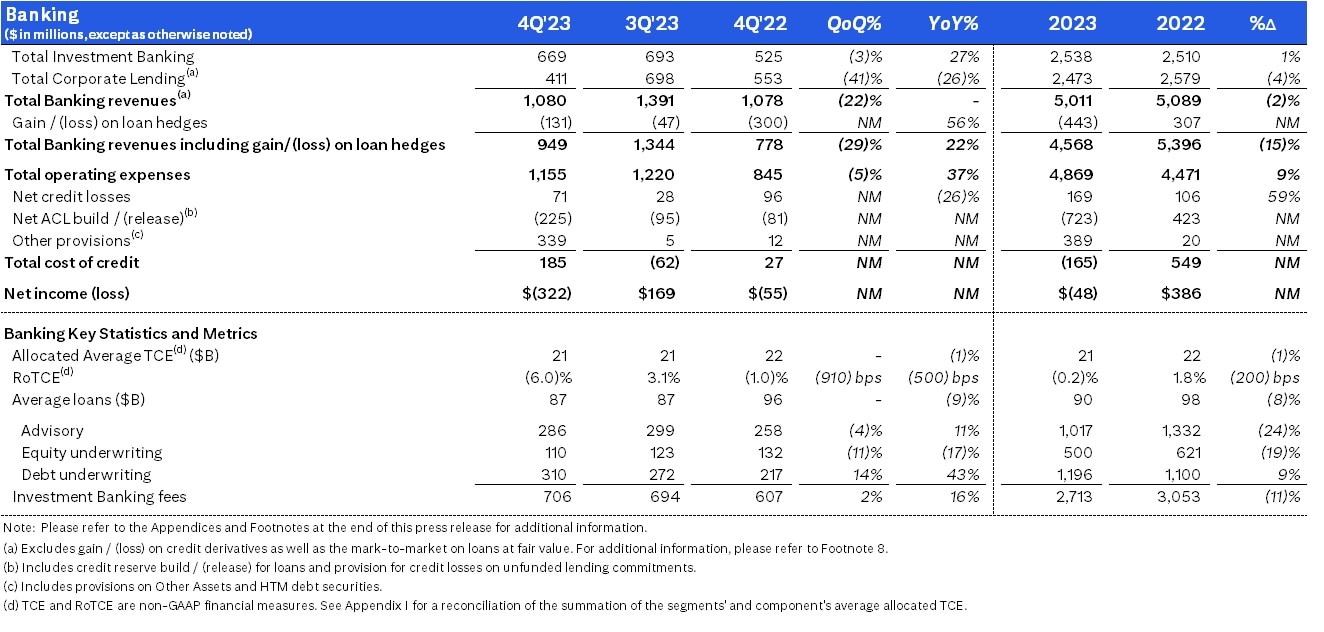
Banking
Banking revenues of $949 million increased 22%, driven by growth in Investment Banking fees and lower losses on loan hedges, partially offset by lower Corporate Lending revenue.
Investment Banking revenues of $669 million increased 27%, driven by Debt Capital Markets (DCM) and Advisory, partially offset by Equity Capital Markets (ECM). Investment Banking fees in Advisory increased 11% versus the prior-year period, reflecting higher client activity. Investment Banking fees in DCM increased 43%, driven by both non-investment and investment grade activity. Investment Banking fees in ECM decreased 17% versus the prior-year period, driven by geopolitical concerns and general IPO market conditions.
Corporate Lending revenues of $411 million, excluding mark-to-market on loan hedges,8 decreased 26% versus the prior-year, largely driven by lower revenue share from Investment Banking, Services and Markets9.
Banking operating expenses of $1.2 billion increased 37%, primarily driven by the absence of an operational loss reserve release in the prior year, as continued investments in talent and infrastructure were offset by productivity savings.
Banking cost of credit was $185 million, compared to $27 million in the prior-year period, driven by a net reserve build of approximately $114 million, primarily associated with the transfer risk in Russia and Argentina.
Banking net loss of $(322) million, was driven by the higher expenses and the higher cost of credit, partially offset by the higher revenues.
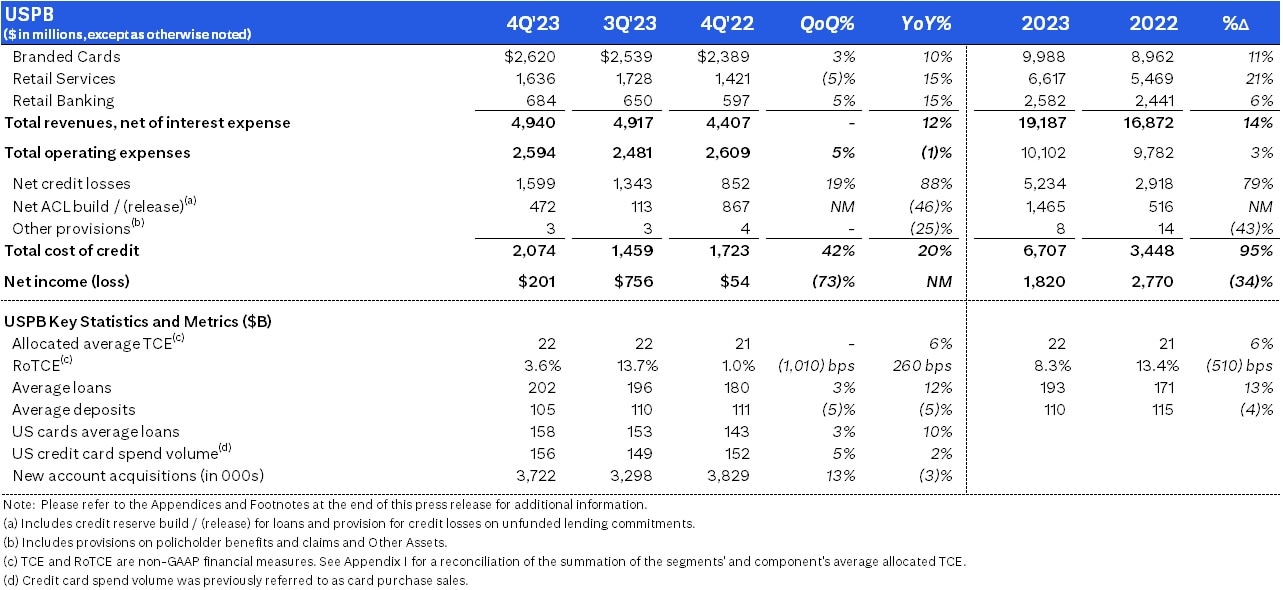
US Personal Banking (USPB)
USPB revenues of $4.9 billion increased 12%, driven by higher net interest income due to loan growth in cards and higher deposit spreads.
Branded Cards revenues of $2.6 billion increased 10%, driven by higher net interest margin and interest-earning balance growth of 13%. Revenue also benefited from growth in new account acquisitions, up 8%, and spend volumes, up 3%.
Retail Services revenues of $1.6 billion increased 15%, driven by higher net interest margin and interest-earning balance growth of 11%, as well as lower partner payments due to higher net credit losses.
Retail Banking revenues of $684 million increased 15%, driven by higher deposit spreads, loan growth and improved mortgage margins.
USPB operating expenses of $2.6 billion decreased 1%, primarily driven by lower non-volume related expenses, partially offset by risk and control and business-led investments.
USPB cost of credit was $2.1 billion, compared to $1.7 billion in the prior-year period. The increase was largely driven by higher net credit losses, which are now at pre-Covid levels, partially offset by a lower ACL build.
USPB net income of $201 million, was driven by the higher revenues and the lower expenses, partially offset by the higher cost of credit.
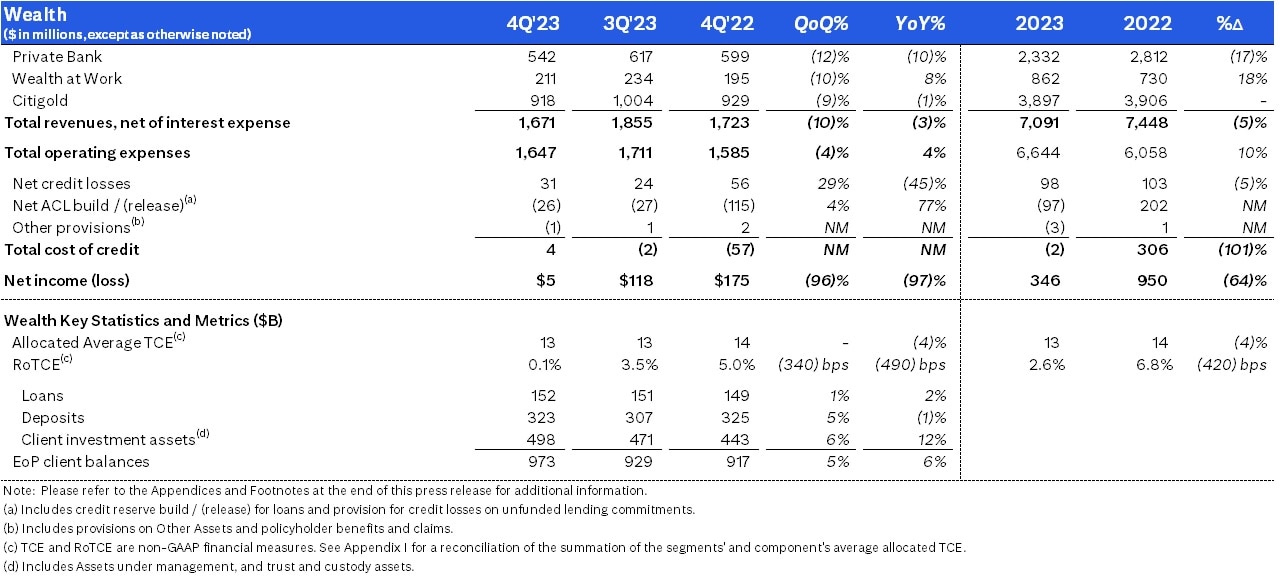
Wealth
Wealth revenues of $1.7 billion decreased 3%, driven by lower deposit spreads, partially offset by lower mortgage funding cost and higher investment fee revenues.
Private Bank revenues of $542 million decreased 10%, driven by lower deposit spreads and lower deposit and loan volumes, partially offset by higher investment revenue.
Wealth at Work revenues of $211 million increased 8%, driven by higher mortgage and investment revenue, partially offset by lower deposit revenue.
Citigold revenues of $918 million decreased 1%, as lower deposit spreads were partially offset by growth in investment revenue globally and higher deposit revenue in Asia.
Wealth operating expenses of $1.6 billion increased 4%, largely driven by investments in risk and controls and technology, partially offset by productivity savings.
Wealth cost of credit was $4 million, as net credit losses of $31 million were largely offset by an ACL release for loans and unfunded commitments of $26 million.
Wealth net income was $5 million, as the lower revenues were largely offset by the higher expenses.
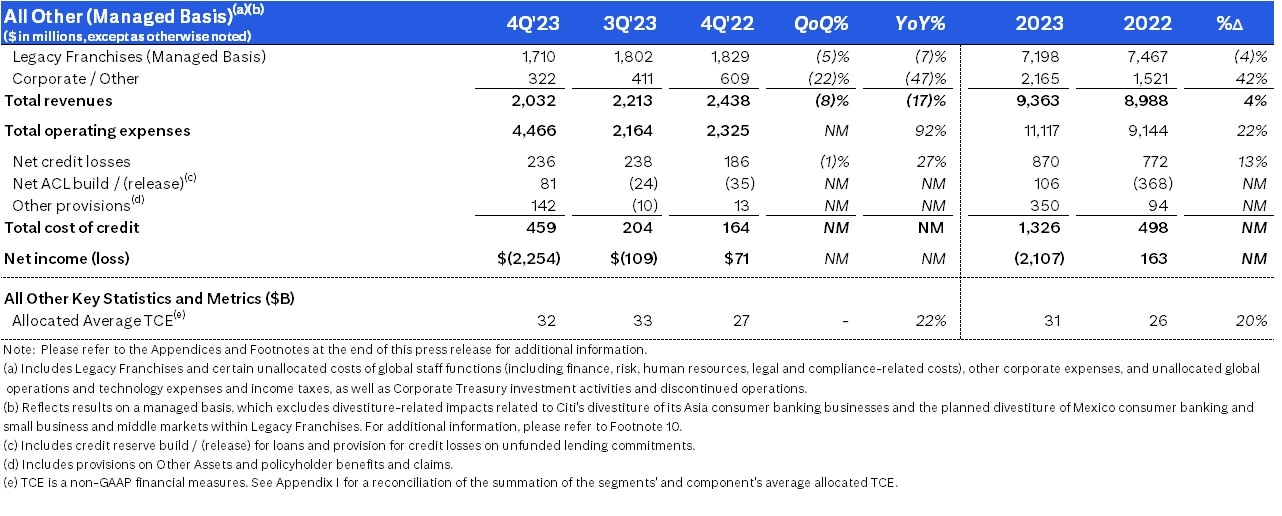
All Other (Managed Basis)10
All Other (Managed Basis) revenues of $2.0 billion decreased 17%, driven by a decrease in net interest income of 29%, largely driven by higher funding costs in Corporate/Other and the closed exits and wind-downs, partially offset by higher non-interest revenue.
Legacy Franchises (Managed Basis)10 revenues of $1.7 billion decreased 7%, primarily driven by the closed exits and wind-downs, partially offset by higher rates and volumes in Mexico and Mexican Peso appreciation.
Corporate / Other revenues decreased to $322 million from $609 million in the prior-year period, in part driven by higher funding costs.
All Other (Managed Basis) expenses of $4.5 billion increased 92%, driven by the FDIC special assessment and the restructuring charge, partially offset by lower expenses driven by the closed exits and wind-downs.
All Other (Managed Basis) cost of credit of $459 million, reflecting net credit losses of $236 million, an ACL build for loans and unfunded commitments of $81 million and other provisions of $142 million.
All Other (Managed Basis) net loss of $(2.3) billion, was driven by the higher expenses, the lower revenues and the higher cost of credit.
Citigroup will host a conference call today at 12:00 PM (ET). A live webcast of the presentation, as well as financial results and presentation materials, will be available at https://www.citigroup.com/global/investors.The live webcast of the presentation can also be accessed at https://www.veracast.com/webcasts/citigroup/webinars/Citi4Q23.cfm.
Additional financial, statistical and business-related information, as well as business and segment trends, is included in a Quarterly Financial Data Supplement. Both this earnings release and Citigroup’s Third Quarter 2023 Quarterly Financial Data Supplement are available on Citigroup’s website at www.citigroup.com.
Citi is a preeminent banking partner for institutions with cross-border needs, a global leader in wealth management and a valued personal bank in its home market of the United States. Citi does business in nearly 160 countries and jurisdictions, providing corporations, governments, investors, institutions and individuals with a broad range of financial products and services.
Additional information may be found at www.citigroup.com | Twitter: @Citi | YouTube: www.youtube.com/citi | Facebook: www.facebook.com/citi | LinkedIn: www.linkedin.com/company/citi
Certain statements in this release are “forward-looking statements” within the meaning of the Private Securities Litigation Reform Act of 1995. These statements are based on management’s current expectations and are subject to uncertainty and changes in circumstances. These statements are not guarantees of future results or occurrences. Actual results and capital and other financial condition may differ materially from those included in these statements due to a variety of factors. These factors include, among others: Citi’s ability to achieve its objectives, including expense savings, from its transformation and strategic and other initiatives, which include the divestiture of Citi’s consumer, small business and middle-market operations in Mexico and other exits and wind-downs, all of which involve significant execution uncertainty and complexity and will result in continued higher expenses and may result in certain losses or other negative financial or strategic impacts; a potential U.S. federal government shutdown and the resulting impacts; continued elevated interest rates and the impacts on macroeconomic conditions, customer and client behavior, as well as Citi’s funding costs; potential recessions in the U.S., Europe and other countries; revisions to the Basel III rules, including the recently issued notice of proposed rulemaking, known as the Basel III Endgame, related to regulatory capital requirements; continued elevated levels of inflation and its impacts; potential increased regulatory requirements and costs, such as the FDIC’s recently issued notice of proposed rulemaking for a special assessment to recover the uninsured deposit losses from recent bank failures; the various uncertainties and impacts related to or resulting from Russia’s war in Ukraine; and the precautionary statements included in this release. These factors also consist of those contained in Citigroup’s filings with the U.S. Securities Exchange and Commission, including without limitation the “Risk Factors” section of Citigroup’s 2022 Form 10-K. Any forward-looking statements made by or on behalf of Citigroup speak only as to the date they are made, and Citi does not undertake to update forward-looking statements to reflect the impact of circumstances or events that arise after the date the forward-looking statements were made.
Contacts:
Investors: Jennifer Landis (212) 559-2718
Press: Danielle Romero-Apsilos (212) 816-2264
(1) Preliminary. Citigroup’s allocated average tangible common equity (TCE) and return on average tangible common equity (RoTCE) are non-GAAP financial measures. RoTCE represents annualized net income available to common shareholders as a percentage of average TCE. For the components of these calculations, see Appendix A. See Appendix G for a reconciliation of common equity to TCE. For a reconciliation of the summation of the segments’ and components’ average allocated TCE to Citigroup’s total average stockholder’s equity, see Appendix I.
(2) Ratios as of December 31, 2023 are preliminary. Citigroup’s Common Equity Tier 1 (CET1) Capital ratio and Supplementary Leverage ratio (SLR) reflect certain deferrals based on the modified regulatory capital transition provision related to the Current Expected Credit Losses (CECL) standard. Excluding these deferrals, Citigroup’s CET1 Capital ratio and SLR as of December 31, 2023 would be 13.2% and 5.8%, respectively, on a fully reflected
basis. For additional information, see “Capital Resources—Regulatory Capital Treatment—Modified Transition of the Current Expected Credit Losses Methodology” in Citigroup’s 2022 Annual Report on Form 10-K. Certain prior period amounts have been revised to conform with enhancements made in the current period.
For the composition of Citigroup’s CET1 Capital and ratio, see Appendix E. For the composition of Citigroup’s SLR, see Appendix F.
(3) Citigroup’s payout ratio is the sum of common dividends and common share repurchases divided by net income available to common shareholders.
(4) Citigroup’s tangible book value per share is a non-GAAP financial measure. See Appendix G for a reconciliation of common equity to tangible common equity and resulting calculation of tangible book value per share.
(5) For additional information on the notable items, see Citi’s Current Report on Form 8-K filed on January 10, 2024 with the U.S. Securities and Exchange Commission. Results of operations excluding the impact of these notable items are non-GAAP financial measures. Citi believes the presentation of its results of operations and financial condition excluding the impacts of these notable items provides a meaningful depiction of the underlying fundamentals of its broader results for investors, industry analysts and others. For a reconciliation to reported results, please refer to Appendix B and C. For a reconciliation to reported EPS, refer to appendix J.
(6) Citi recorded an approximate $880 million translation loss in revenues in Argentina in the fourth quarter of 2023 due to the recent devaluation of the Argentine peso. This decrease in revenues impacted Services, Markets, and Banking. The translation loss does not include net interest income of approximately $250 million on Citi’s net investment in Argentina in the quarter.
(7) Fourth quarter 2023 results included divestiture-related impacts of $(138) million in earnings before taxes (approximately $(111) million after-tax). This amount included $(62) million revenues from certain divestitures, recorded in Other revenue, $106 million of aggregate divestiture-related costs, recorded in Operating expenses, a $(30) million of divestiture-related credit costs, and related taxes of $(27) million.
Fourth quarter 2022 results included divestiture-related impacts of $192 million in earnings before taxes (approximately $113 million after-tax). This amount included $209 million primarily related to the gain on sale from certain divestitures, recorded in Other revenue, $58 million of aggregate divestiture-related costs, recorded in Operating expenses, a $41 million benefit of divestiture-related credit costs, and related taxes of $79 million.
Results of operations excluding these divestiture-related impacts are non-GAAP financial measures. For additional information and a reconciliation to reported results, please refer to Appendix B and D.
(8) Credit derivatives are used to economically hedge a portion of the Corporate Lending portfolio that includes both accrual loans and loans at fair value. Gain / (loss) on loan hedges includes the mark-to-market on the credit derivatives and the mark-to-market on the loans in the portfolio that are at fair value. In the fourth quarter 2023, gain / (loss) on loan hedges included $(131) million related to Corporate Lending, compared to $(300) million in the prior-year period. The fixed premium costs of these hedges are netted against the Corporate Lending revenues to reflect the cost of credit protection. Citigroup’s results of operations excluding the impact of gain / (loss) on loan hedges are non-GAAP financial measures. For a reconciliation to reported results, please refer to Appendix H.
(9) Certain revenues earned by Citi are subject to a revenue sharing agreement to Banking – Corporate Lending from Investment Banking and certain Markets and Services products sold to clients.
(10) All Other (Managed Basis) reflects results on a managed basis, which excludes divestiture-related impacts, for all periods, related to Citi’s divestitures of its Asia consumer banking businesses and the planned divestiture of Mexico consumer banking and small business and middle market banking within Legacy Franchises. Certain of the results of operations of All Other (Managed Basis) and Legacy Franchises (Managed Basis) that exclude divestiture-related impacts are non-GAAP financial measures. Citi believes the presentation of its results of operations excluding these divestiture-related impacts provide a meaningful depiction of the underlying fundamentals of its All Other (Managed Basis) and Legacy Franchises (Managed Basis) results for investors, industry analysts and others, including increased transparency and clarity into operating results, improved visibility into management decisions and their impacts on operational performance; enables better comparison to peer companies; and allows Citi to provide a long-term strategic view of the category going forward. In addition, Citi’s Chief Operating Decision Maker, or its Chief Executive Officer, regularly reviews financial information on a managed basis that excludes these divestiture-related impacts. For additional information and a reconciliation of these results, please refer to Appendix D.
